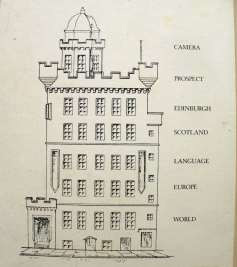THE FIRST OUTLOOK TOWER
EDINBURGH’S OLD TOWN

Cities in the past, at their very heart, contained a special place where their gods, ideals and aspirations dwelled. The Parthenon in Athens, the Roman Forum, the great cathedrals in the Middle Ages. Human spirit, even in a secular society, still needs this sacred space for reflection and contemplation, a place to ponder the imponderable, to think the unthinkable.
Geddes thought that such a place for Edinburgh should be in its very heart, in the Old Town.
In answer to the need for a special place in the heart of the Town, Geddes bought the Outlook Tower in 1892. Geddes did not design the Outlook Tower; it had in fact previously been occupied by an optician and still contained optical instruments, but its location at the top of the Royal Mile with a panoramic view over the whole region appealed to him from the outset. From then onwards it became the headquarters and keystone of all his activities in Britain – a hub for the Summer meetings; an Index Museum of the Universe; a Sociological Laboratory Home of the old School of Art; Headquarters of “Geddes and Colleagues” publishing venture.
The upward structure of the Tower symbolises the human desire to transcend temporal existence and restore the link between heaven and earth. The Outlook Tower became the power house for Geddes’ regeneration of the Old Town of Edinburgh. A visit to the Outlook tower was designed to orient the individual towards ethical ideals conducive to full and active participation in civic life and government of the city.
SOCIOLOGICAL LABORATORY
The cupola at the top of the tower held a camera obscura which, by means of a mirror and lens, reflected images of the surrounding area onto a table for spectators to see. The effect of this for Geddes was to focus one’s attention on the specific environment and to reveal the natural and social forces at work within it. It was the starting point for an immensely ambitious display linking the individual and the immediate environment to a continuum which extended to take in the world: an “Index Museum” whose aim was nothing short of a synthesis of knowledge.
From the camera obscura the visitor would emerge to the “Prospect” a balcony to view the city as a whole, and then proceed down to the Edinburgh Room, continuing his descent through each successive floor devoted to Scotland, the English-speaking countries, Europe and the World. Each room contained various exhibits to classify and interpret the accumulated information, the Edinburgh Room having, on the floor, a large relief model of the Forth region as well as maps, diagrams, photographs, paintings and documents relating to mineral industrial, educational and social resources. Similar material was used to reveal the pattern of growth of the city over several centuries providing a historical context for the contemporary data. The room devoted to Scotland also had a relief map ‘to make the land concrete to the imagination’ and a frieze of Celtic history, while the walls of the Europe Room were covered with a vast coloured chart illustrating European history from the 4th to the 19th century.
On the lowest floor, the World Room was dominated by two large globes designed by the French geographer Elisce Reclus illustrating land formations and the plant life which they support. Although workable, this collection was never completed, if indeed it ever could be, and his plans to organise similar centres in different parts of the world never really got off the ground, but the Outlook Tower brought together the various activities of the previous decade and for the first and perhaps only time demonstrated Geddes’ view to ‘conceive life as a whole’.
RIDDLE’S COURT
Riddles Court is one of the most important historic buildings still extant in the Old Town of Edinburgh. On the south side of the Lawnmarket in the Old Town of Edinburgh, an arched pend leads through to Riddle Court. In 1887 Geddes chiselled his motto “Vivendo Discimus” (by living we learn) on the archway leading into the inner courtyard of Riddles Court. In 1890 it was opened as a self governing student University Hall of Residence.

Riddles Court 
Riddles Court Today
[Its reconstruction by SHBT as the Patrick Geddes Centre, a new take on the Outlook Tower]
1590 John McMorran built his new home on this site around a courtyard, away from the noise of the Lawnmarket.
1598 The house was used to host a magnificent state banquet, attended by King James VI of Scotland and Queen Anne as their wedding reception.
1726 George Riddell reconstructed part of the building. The property became known as Riddells Court.
1751 David Hume, the famous philosopher, moved into Riddells Court.
1887 Patrick Geddes used it for his summer meetings and the building became a self governing students’ residence for ladies.
1947 Riddles Court bought by the City Council and became home to the Workers Educational Association (WEA)
[Its reconstruction by SHBT as the Patrick Geddes Centre]
A modern “Thinking Machine” in Geddes’ style by Sofia Leonard for the GEDDES Centre’s functions.
